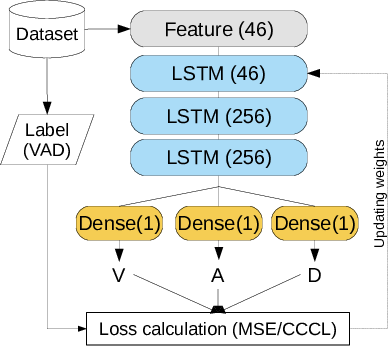Evaluation of Error and Correlation-Based Loss Functions For Multitask Learning Dimensional Speech Emotion Recognition
by Bagus Tris Atmaja Masato Akagi, Email: bagus@ep.its.ac.id
This is a repository for that paper that provide Python codes, Latex codes figures, and other materials.
This paper has been submitted for publication in APSIPA 2020.
Architecture of evaluated system.
The choice of a loss function is a critical part in machine learning. This paper evaluated two different loss functions commonly used in regression-task dimensional speech emotion recognition, an error-based and a correlation-based loss functions. We found that using correlation-based loss function with a concordance correlation coefficient (CCC) loss resulted better performance than error-based loss function with a mean squared error (MSE) loss, in terms of the averaged CCC score. The results are consistent with two input feature sets and two datasets. The scatter plots of test prediction by those two loss functions also confirmed the results measured by CCC scores.
All source code used to generate the results and figures in the paper are in
the code folder.
The calculations and figure generation are all run from Python codes.
The data used in this study is provided in data and the sources for the
manuscript text and figures are in manuscript.
Results generated by the code are saved in results.
See the README.md files in each directory for a full description.
You can download a copy of all the files in this repository by cloning the git repository:
git clone https://github.com/bagustris/ccc_mse_ser.git
You'll need a working Python environment to run the code.
The recommended way to set up your environment is through the
Anaconda Python distribution which
provides the conda package manager.
Anaconda can be installed in your user directory and does not interfere with
the system Python installation.
The required dependencies are specified in the file requirements.txt.
We use pip virtual environments to manage the project dependencies in
isolation.
Thus, you can install our dependencies without causing conflicts with your
setup (even with different Python versions).
Run the following command in the repository folder (where environment.yml
is located) to create a separate environment and install all required
dependencies in it:
pip3.6 venv REPO_NAME
Before running any code, you must activate the conda environment:
source activate REPO_NAME
To reproduce the result, run the following in order:
Search the code the generate feature under my profile. An example is to use code from the following repo: https://github.com/bagustris/dimensional-ser/tree/master/code/extract_feature
$ python code/ser_iemocap_gemaps_ccc.pyAll source code is made available under a BSD 3-clause license. You can freely
use and modify the code, without warranty, so long as you provide attribution
to the authors. See LICENSE.md for the full license text.
The manuscript text is not open source. The authors reserve the right to the article content.
B. T. Atmaja and M. Akagi, “Deep Multilayer Perceptrons for Dimensional Speech Emotion Recognition,”
in 2020 Asia-Pacific Signal and Information Processing Association Annual Summit and Conference,
APSIPA ASC 2020 - Proceedings, 2020, pp. 325–331.
